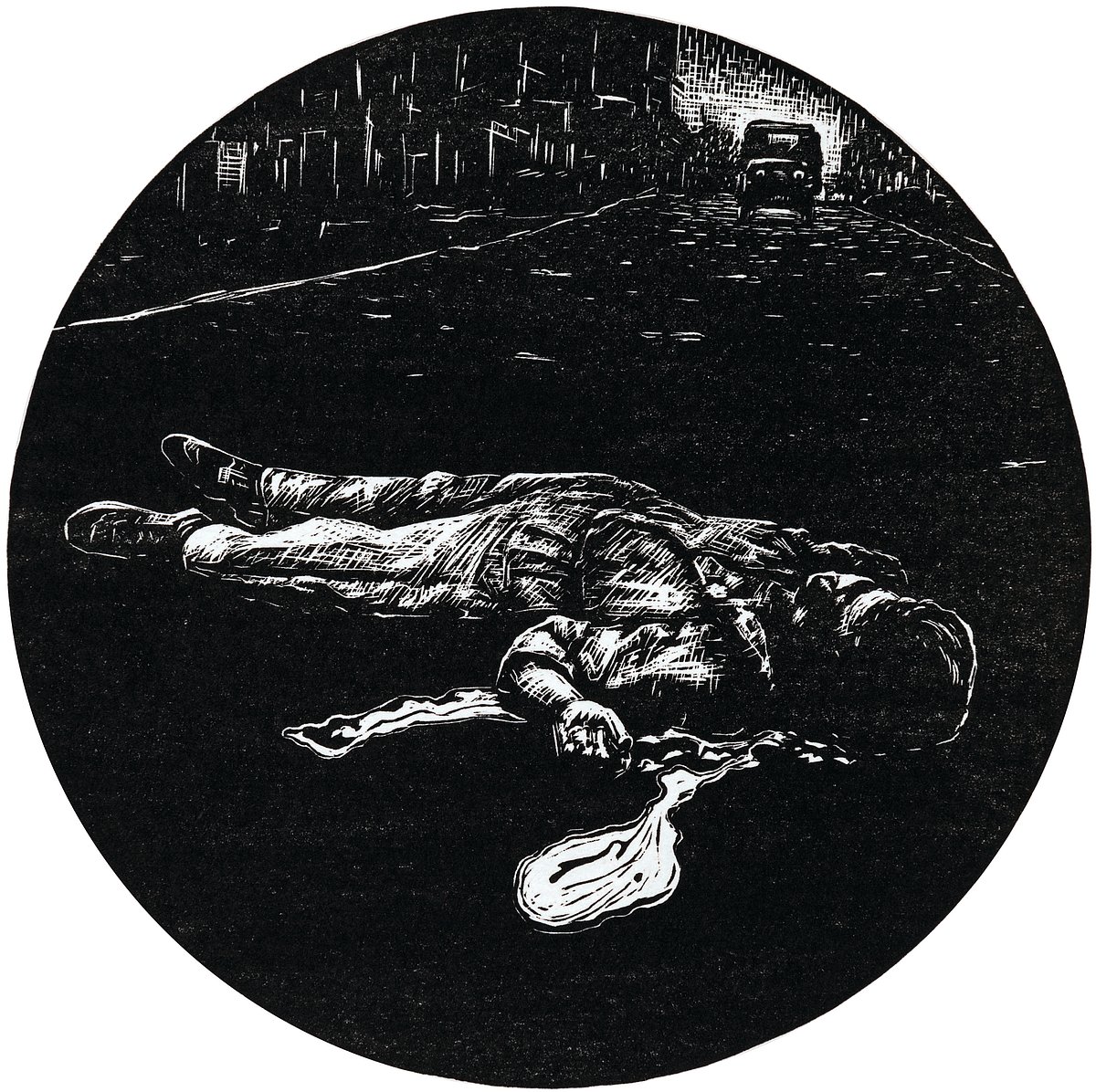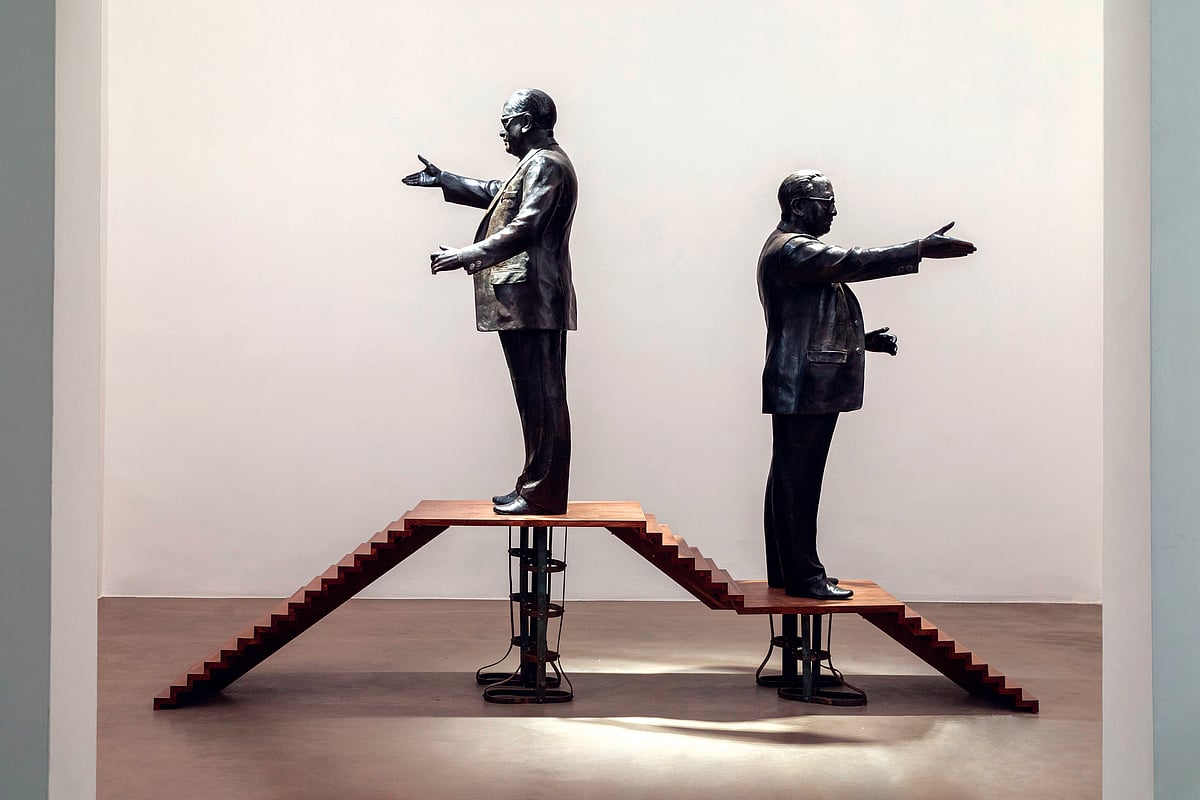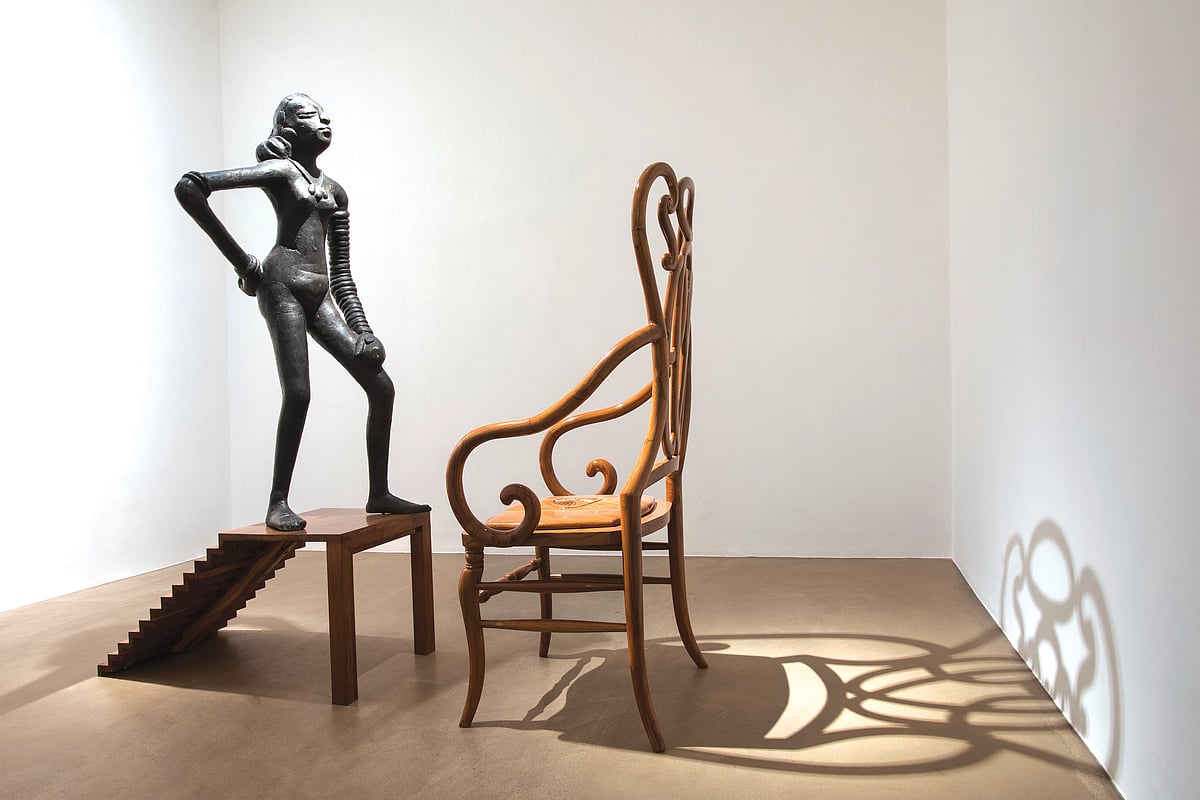Riyas Komu: Silence is a powerful enemy of social justice
Riyas Komu’s latest show Holy Shiver looks at how our everyday lives are barraged with stories of animosity towards ‘the other’ and also with violence to establish a nationalised identity

At the entry point to artist Riyas Komu’s solo show titled Holy Shiver, exhibited at Vadehra Art Gallery, is a lion in front of iron bushes covering our Ashoka Stambh, seemingly ready to pounce. But as you walk around to take in the work, you realise it is a lapping lion. And there lies the incredibility of the Kochi-Muziris Biennale co-founder’s work. It is never simply what it is.
Behind this lion are 26 pages of the Indian Constitution, which have been digitally scanned and printed on one side and to the right of it are mirror images of the same text, but behind half darkened frames rendering the text illegible. This is the second part of the three-part installation titled Fear-1. Opposite the lion are woodcut prints where images of violence and suppression from the time of Partition are showcased. It includes the 1984 anti-Sikh riots, 1993 Bombay blasts, 2002 Gujarat riots, 2016 Una violence against Dalits and the 2017 killing of Junaid Khan near Delhi.
Questioning and engaging is Komu’s way of pointing out and dealing with the changing narrative. “The work titled ‘Fear’ celebrates the Constitution and also points to our recent conversations around it. I think the Constitution establishes the dream of India—a “sovereign, socialist, secular, democratic republic”. The erasure or modification of even one of those ideals would dent the idea of India and the pluralities that we hold so dear. Recently we have seen many attempts to not only amend the constitution but to amend it in such a way that we roll back years of social progress,” elaborates Komu.
Soon enough, you come across sculptures of BR Ambedkar on a pedestal supported by metal legs. “I am interested in Ambedkar’s ideas and how they interact with (and within) the available social, cultural, and political structures. There is no dispute on Ambedkar’s role in establishing the ideals of the modern republic or on the value of his writings, his ideas or in his resolute demands in Annihilation of Caste,” says Komu with fervent hope in his voice.
“We need him urgently today, but the way to do that is not to place him on a pedestal but rather to look at his ideas outside the constructs of just popular thinking. How do we see him as someone for our times? How do we see him as a thinker and as a philosopher?” asks Komu.
Continuing with his metaphorical theme and effort for a narrative to build around the work, rather than vice-versa, there is the installation I think, therefore I am, which has the replica of the ‘dancing girl’ made famous after being excavated from the Mohenjodaro site, facing a throne-like chair. “Many historians have already disputed the assessment of her being a ‘dancing girl’. Nevertheless, it’s a captivating piece of art and I thought it would be interesting to give her a space to argue for herself who she is. I am not interested in building a narrative for her (as we have done with women throughout centuries), but was rather interested to see if new narratives could emerge,” points out Komu.
Some of his works may be in-your-face, like the wood sculpture titled National Flower depicting a blooming lotus, rising on the strength of muscular men, whether with a 56-inch chest or not, is for us to decipher. Then there is a wall of red stars titled Public Action indicative of the rise of ranks of those initiating action against the public.
The title of Komu’s show takes its reference from a conceptual strand discussed by Austrian zoologist and ethologist Konrad Lorenz in his book, On Aggression. Lorenz argued that whilst animal and human aggressive behaviour was motivated by survival, aggressive behaviour in humans is not appropriately shaped and modified. Lorenz had a rather bleak view of the human race and said that the degree of violence that humans direct toward their own kind is unmatched even by the fiercest animal.
Komu believes that though art has the potential to produce meaningful political critique, reimagine our realities, influence perceptions, and affect people in aesthetic, emotional, and sensory ways, he doesn’t think we should depend on arts as a tool to affect social change, mostly because, “how many people in India have access to, or are inclined to look at arts for inspiration?”
But art can be the means. “That’s why it’s important to have initiatives like the Kochi-Muziris Biennale which is not “art for art’s sake”, but is a cultural platform that seeks to open up new discourses and engage the public in new ways of seeing. I believe it’s this access to new ideas and ways of seeing that will, in the end, educate people. That’s why we also have to promote critical thinking in schools and encourage
our children to ask questions—even if they are difficult for us to answer.”
Excerpts from an interview with the artist:
Not many artists are responding to the current socio-political situation in the country. Why did you choose to and what made you?
I don’t think that’s true. Many artists are responding to our current socio-political unrest. I also see that the young and upcoming artists also have a particular interest in the political—especially if you look at the works in the Students’ Biennale. If you consider how the government has been reacting to student protests and engaging in cultural censorship, it’s obvious that they are not just interested in flattening dissent but in crushing thought itself. This deliberate act of silencing those who voice their opinions, will lead to many voices (especially from the minorities) not being represented at all in the larger public discourse and subsequently excluded from the democratic process itself. The attempt is to remove diversity in favour of homogeneity. This failure to intellectually and conceptually contemplate diversity was perhaps best exemplified when Winston Churchill famously said that India was no more a country than the Equator. His thinking is that such diversity could not (and perhaps should not) fit into the concept of a single country. So, my objective is not to be reactionary, but to present socio-political unrest in ways that would further our understanding of it and possibly create new discourses around it. And sometimes this requires us to be very direct. To be silent is not an option; for silence is a powerful enemy of social justice.
In the triptych titled ‘Dhamma Swaraj’, you have begun with a prominent Gandhi, moving towards a prominent Ambedkar. What is the statement you’d like to make because many readers of history say they were politically opposed?
The Gandhi-Ambedkar debate is fascinating. ‘Dhamma Swaraj’, is an overlapping triptych portrait of Gandhi and Ambedkar that explores the interaction between two apparently disparate ideologies in the scope of a single frame. I am not trying to ascertain any one ideology over the other, but simply trying to appreciate their quest for truth and humanity, with all its complex uncertainties, at the centre. I think this is relevant now more than ever. We are increasingly afraid to even mention caste in our public discourses and those who do, do so for a certain agenda. While many today eagerly point to the ill-effects of neoliberalism and what it is doing to our country (correctly), we still avoid the larger issue of caste that still, in many ways, drives the idea of India. Neoliberalism is, in certain ways, helping cement this idea further. That’s also why we are witnessing some open questioning of the ideas of representation in our electorate and democratic systems. Ambedkar believed that the right to representation is a basic right, but Gandhi was against granting “untouchables” the right to self-represent. But at the same time, Ambedkar spoke harshly about the Adivasis almost to the point of their exclusion from “civilised politics” and was unmindful of the effects of ‘modernity’ and ‘urbanisation’. These are not new arguments or findings, but I am attempting to present a new way of looking at what we already know in the contemporary context.
Follow us on: Facebook, Twitter, Google News, Instagram
Join our official telegram channel (@nationalherald) and stay updated with the latest headlines
- Partition
- Dr BR Ambedkar
- Indian Constitution
- Gandhiji
- 2002 Gujarat riots
- remarks on the Constitution
- Riyas Komu
- Holy Shiver
- Vadehra Art Gallery
- dancing girl
- mohenjadaro
- killing of Junaid Khan
- Bombay blasts
- Una violence
- 1984 anti-Sikh riots
- Kochi-Muziris Biennale co-founder
- 2016 Una violence against Dalits
- modern republic



